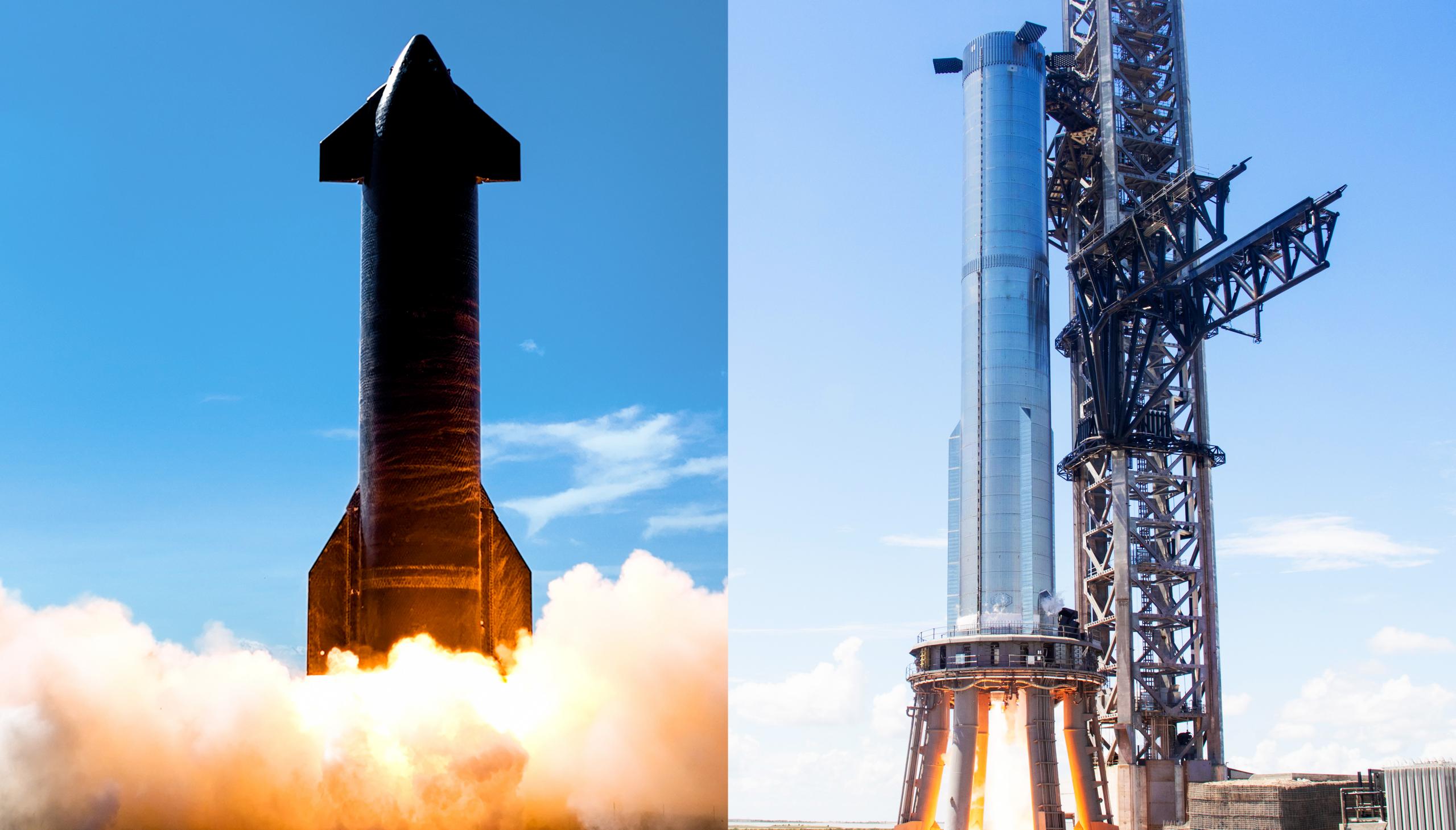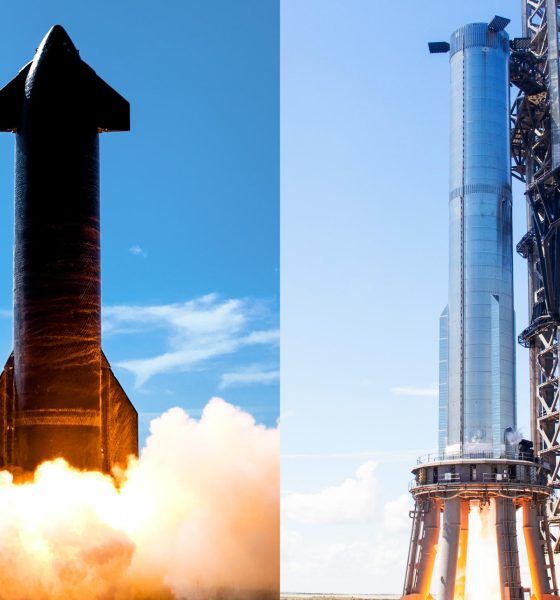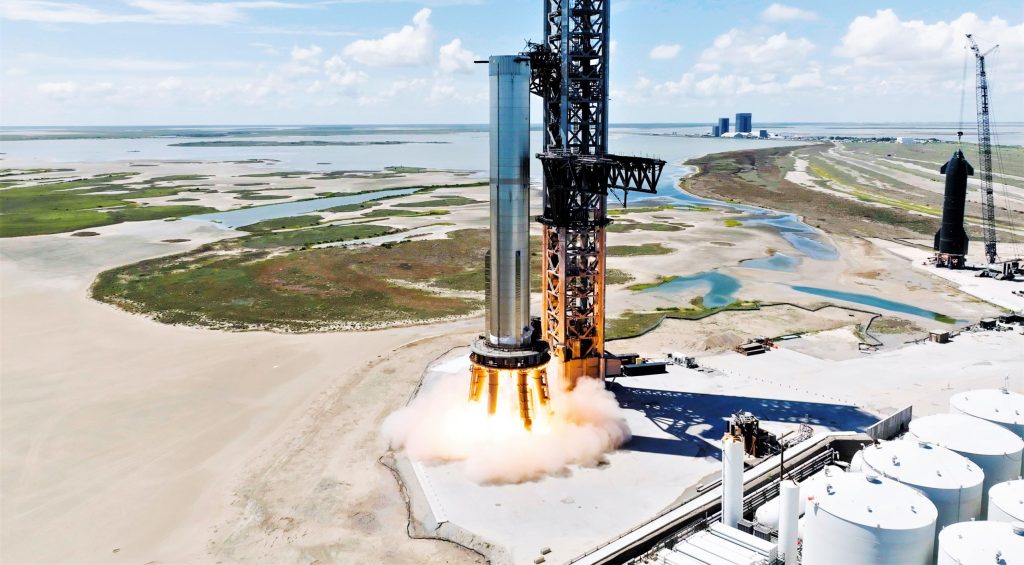

News
SpaceX’s first orbital Starship launch “highly likely” in November, says Elon Musk
CEO Elon Musk says that it’s “highly likely” SpaceX will be ready to attempt its first orbital Starship launch in November 2022, and possibly as early as late October. But many major hurdles remain.
Adding to a welcome burst of insight into SpaceX’s fully-reusable Starship rocket program, Musk took to Twitter on September 21st to provide a bit more specific insight into the company’s next steps towards a crucial orbital launch debut. On September 19th, the CEO revealed that SpaceX would roll the Starship booster (B7) currently assigned to that debut back to the factory for mysterious “robustness upgrades” – an unexpected move right after a seemingly successful and record-breaking static fire test.
Two days later, Musk has indicated that those upgrades might involve fortifying Super Heavy Booster 7’s thrust section to ensure it can survive Raptor engine failures. With 33 Raptor V2 engines powering it and plenty of evidence that those Raptors are far from perfect reliability, the concern is understandable, even if the response is a bit different than SpaceX’s norm.
Prior to the start of preparations for Starship’s orbital launch debut, SpaceX sped through Starship development like it wanted to destroy as many rockets as possible – which, to some extent, it did. Rather than spend 6-12 months fiddling with the same few prototypes without a single launch attempt, SpaceX churned out Starships and test articles and aggressively tested them. A few times, SpaceX pushed a little too hard and made avoidable mistakes, but most of the failures produced large amounts of data that was then used to improve future vehicles.
The holy grail of that project was high-altitude Starship flight testing, which saw SpaceX finish, test, and launch a new Starship five times in six months, and culminated in the first fully successful high-altitude Starship launch and landing in May 2021.
In comparison, SpaceX’s orbital flight test preparations have been almost unrecognizable. While a good amount of progress has been made in the 16 months since SN15’s successful launch and landing, it’s clear that SpaceX has decided against taking significant risks. After spending more than six months slowly finishing and testing Super Heavy Booster 4 and Starship 20, the first orbital-class pair, SpaceX never even attempted a single Booster 4 static fire and unceremoniously retired both prototypes without attempting to fly either.
Without info from Musk or SpaceX, we may never know why SpaceX stood down B4 and S20, or why the company appears to have revised its development approach to be a bit more conservative after clearly demonstrating the efficacy of moving fast and taking big risks. It’s possible that winning a $3 billion contract that places Starship front and center in NASA’s attempt to return astronauts to the Moon has encouraged a more careful approach. SpaceX won that contract in April 2021.
Even in its more cautious third phase, Starship development is still extraordinarily hardware-rich, moving quickly, and uncovering many problems on the ground in lieu of learning from flight tests. But that doesn’t change the fact that the third phase of Starship development (H2 2021 – today) is proceeding more carefully than the first (Q4 2018 to Q4 2019) and second (Q1 2020 – Q2 2021) phases.
Nonetheless, SpaceX appears to finally be getting closer to Starship’s first orbital launch. According to Musk, the company could be ready for the first launch attempt as early as late October, but a November attempt is “highly likely.” He believes that SpaceX will have two pairs of orbital-class Starships and Super Heavy boosters (B7/S24; B8/S25) “ready for orbital flight by then,” potentially enabling a rapid return to flight after the first attempt. Musk is also excited about Super Heavy Booster 9, which has “many design changes” and a thrust section that will fully isolate all 33 Raptors from each other – crucial for preventing the failure of one engine from damaging others.
Meanwhile, as Musk forecasted, Super Heavy Booster 8 rolled to the launch pad on September 19th and will likely be proof tested in the near future while Booster 7 is upgraded back at the factory.
Encouraging as that may be, history has shown that reality – particularly when it involves Starship’s orbital launch debut – can be quite a bit different than the pictures Elon Musk paints. In September 2021, for example, Musk predicted that SpaceX would conduct the first Super Heavy static fire at Starbase’s orbital launch pad later that month. In reality, that crucial test occurred 11 months later (August 9th, 2022) and used an entirely different booster.
This is to say that significant progress has been made in the last few months, but SpaceX has a huge amount of work left, almost all of which lies in uncharted terrain. Starship 24, which completed its first six-engine static fire earlier this month, is currently undergoing strange modifications that seem to imply that the upper stage is not living up to SpaceX’s expectations. It’s unclear if additional testing will be required.
Super Heavy B7 is headed back to the factory for additional work after a successful seven-Raptor static fire. Once it returns to the pad, the sequencing isn’t clear, but SpaceX will need to complete the first full Super Heavy wet dress rehearsal (fully loading the booster with thousands of tons of flammable propellant) and the first full 33-Raptor static fire. It remains to be seen if SpaceX will continue its conservative approach (i.e. testing one, three, and seven engines over six weeks) or jump straight from seven- to 33-engine testing.
It’s also unclear where Ship 24 fits into that picture. SpaceX will eventually need to (or should) conduct a full wet dress rehearsal of the fully stacked Starship and may even want to attempt a 33-engine static fire with that fully-fueled two-stage vehicle to truly test the rocket under the same conditions it will launch under. Will SpaceX fully stack B7 and S24 as soon as the booster returns to the pad, risking a potentially flightworthy Starship during the riskiest Super Heavy tests yet?

SpaceX’s last year of activity suggests that the company will choose caution and conduct wet dress rehearsals and 33-engine static fires before and after stacking, potentially doubling the amount of testing required. One or several more tests will also be required if SpaceX decides to gradually build up to 33 engines, which is the approach that all Booster 7 activity to date suggests SpaceX will take.
Either way, it will be a major challenge for SpaceX to have a fully-stacked Starship ready to launch by the end of November. If any significant problems arise during any of the several unprecedented tests described above, Musk’s predicted schedule will likely become impossible. As a wildcard, the Federal Aviation Administration (FAA) has yet to issue SpaceX a license or experimental permit for orbital Starship launches, either of which is contingent upon dozens of “mitigations.”
This isn’t to say that it’s impossible for an orbital Starship launch attempt to occur in November. But factoring in the many issues Booster 7 and Ship 24 have experienced during much simpler tests, it’s becoming increasingly implausible that SpaceX will be ready to launch the pair before the end of 2022. Stay tuned.

News
Tesla FSD fleet is nearing 7 billion total miles, including 2.5 billion city miles
As can be seen on Tesla’s official FSD webpage, vehicles equipped with the system have now navigated over 6.99 billion miles.

Tesla’s Full Self-Driving (Supervised) fleet is closing in on almost 7 billion total miles driven, as per data posted by the company on its official FSD webpage.
These figures hint at the massive scale of data fueling Tesla’s rapid FSD improvements, which have been quite notable as of late.
FSD mileage milestones
As can be seen on Tesla’s official FSD webpage, vehicles equipped with the system have now navigated over 6.99 billion miles. Tesla owner and avid FSD tester Whole Mars Catalog also shared a screenshot indicating that from the nearly 7 billion miles traveled by the FSD fleet, more than 2.5 billion miles were driven inside cities.
City miles are particularly valuable for complex urban scenarios like unprotected turns, pedestrian interactions, and traffic lights. This is also the difference-maker for FSD, as only complex solutions, such as Waymo’s self-driving taxis, operate similarly on inner-city streets. And even then, incidents such as the San Francisco blackouts have proven challenging for sensor-rich vehicles like Waymos.
Tesla’s data edge
Tesla has a number of advantages in the autonomous vehicle sector, one of which is the size of its fleet and the number of vehicles training FSD on real-world roads. Tesla’s nearly 7 billion FSD miles then allow the company to roll out updates that make its vehicles behave like they are being driven by experienced drivers, even if they are operating on their own.
So notable are Tesla’s improvements to FSD that NVIDIA Director of Robotics Jim Fan, after experiencing FSD v14, noted that the system is the first AI that passes what he described as a “Physical Turing Test.”
“Despite knowing exactly how robot learning works, I still find it magical watching the steering wheel turn by itself. First it feels surreal, next it becomes routine. Then, like the smartphone, taking it away actively hurts. This is how humanity gets rewired and glued to god-like technologies,” Fan wrote in a post on X.
News
Tesla starts showing how FSD will change lives in Europe
Local officials tested the system on narrow country roads and were impressed by FSD’s smooth, human-like driving, with some calling the service a game-changer for everyday life in areas that are far from urban centers.

Tesla has launched Europe’s first public shuttle service using Full Self-Driving (Supervised) in the rural Eifelkreis Bitburg-Prüm region of Germany, demonstrating how the technology can restore independence and mobility for people who struggle with limited transport options.
Local officials tested the system on narrow country roads and were impressed by FSD’s smooth, human-like driving, with some calling the service a game-changer for everyday life in areas that are far from urban centers.
Officials see real impact on rural residents
Arzfeld Mayor Johannes Kuhl and District Administrator Andreas Kruppert personally tested the Tesla shuttle service. This allowed them to see just how well FSD navigated winding lanes and rural roads confidently. Kruppert said, “Autonomous driving sounds like science fiction to many, but we simply see here that it works totally well in rural regions too.” Kuhl, for his part, also noted that FSD “feels like a very experienced driver.”
The pilot complements the area’s “Citizen Bus” program, which provides on-demand rides for elderly residents who can no longer drive themselves. Tesla Europe shared a video of a demonstration of the service, highlighting how FSD gives people their freedom back, even in places where public transport is not as prevalent.
What the Ministry for Economic Affairs and Transport says
Rhineland-Palatinate’s Minister Daniela Schmitt supported the project, praising the collaboration that made this “first of its kind in Europe” possible. As per the ministry, the rural rollout for the service shows FSD’s potential beyond major cities, and it delivers tangible benefits like grocery runs, doctor visits, and social connections for isolated residents.
“Reliable and flexible mobility is especially vital in rural areas. With the launch of a shuttle service using self-driving vehicles (FSD supervised) by Tesla in the Eifelkreis Bitburg-Prüm, an innovative pilot project is now getting underway that complements local community bus services. It is the first project of its kind in Europe.
“The result is a real gain for rural mobility: greater accessibility, more flexibility and tangible benefits for everyday life. A strong signal for innovation, cooperation and future-oriented mobility beyond urban centers,” the ministry wrote in a LinkedIn post.
News
Tesla China quietly posts Robotaxi-related job listing
Tesla China is currently seeking a Low Voltage Electrical Engineer to work on circuit board design for the company’s autonomous vehicles.

Tesla has posted a new job listing in Shanghai explicitly tied to its Robotaxi program, fueling speculation that the company is preparing to launch its dedicated autonomous ride-hailing service in China.
As noted in the listing, Tesla China is currently seeking a Low Voltage Electrical Engineer to work on circuit board design for the company’s autonomous vehicles.
Robotaxi-specific role
The listing, which was shared on social media platform X by industry watcher @tslaming, suggested that Tesla China is looking to fill the role urgently. The job listing itself specifically mentions that the person hired for the role will be working on the Low Voltage Hardware team, which would design the circuit boards that would serve as the nervous system of the Robotaxi.
Key tasks for the role, as indicated in the job listing, include collaboration with PCB layout, firmware, mechanical, program management, and validation teams, among other responsibilities. The role is based in Shanghai.
China Robotaxi launch
China represents a massive potential market for robotaxis, with its dense urban centers and supportive policies in select cities. Tesla has limited permission to roll out FSD in the country, though despite this, its vehicles have been hailed as among the best in the market when it comes to autonomous features. So far, at least, it appears that China supports Tesla’s FSD and Robotaxi rollout.
This was hinted at in November, when Tesla brought the Cybercab to the 8th China International Import Expo (CIIE) in Shanghai, marking the first time that the autonomous two-seater was brought to the Asia-Pacific region. The vehicle, despite not having a release date in China, received a significant amount of interest among the event’s attendees.








